Nikon D3X Review
Nikon D3X Introduction
The Nikon D3X is the flagship Digital SLR from Nikon. It boasts a 25 megapixels image sensor, the highest resolution among full-frame models, with 5 FPS output and a sensitivity range extensible to ISO 50-6400. As expected from a professional camera, the D3X has a 100% coverage viewfinder, weather-sealed body and dual-control dials.
This large DSLR includes a built-in vertical grip with its own shutter-release and dual control-dials. The large viewfinder features an internal shutter to prevent light from entering during long exposures. The D3X has dual Compact-Flash slots and a comes with a dual-battery charger for its Lithium-Ion battery.
This review takes a close look at the Nikon D3X in terms of features, ergonomics, usability, performance and image quality.
Nikon D3X Key Features
Sensor
- 24 Megapixels Full-Frame CMOS sensor
- ISO 100-1600 Standard sensitivity
- Expanded ISO 50, 3200-6400
- Customizable Auto ISO parameters
- JPEG, RAW or JPEG+RAW Output
Exposure
- PASM Exposure modes
- 1/8000s-30s Shutter-speed, plus Bulb
- EC, ±5 EV, 1/2, 1/3 or 1 EV steps
- Matrix (Multi-Segment), Center-Weighed, Average & Spot metering
- AEB, 2-9 Frames, ±1 EV, 1/3 or 1/2 EV steps
- AE, AE & Flash, Flash, WB bracketing
- ½, 1/3 or 1 EV Exposure steps
- Exposure fine-tuning, ±1 EV, 1/6 EV steps
Focus & Drive
- 51-Point autofocus, 15 cross-type
- Center, Single-Point or Auto focus-point
- Single-Shot, Continuous or Manual focus-drive
- Contrast-Detect autofocus during Live-View
- 5 FPS Continuous Drive, Max 70 JPEG or 34 RAW
- Self-Timer, 2, 5, 10 or 20s
- Mirror-Up and Exposure-Delay
- Wired remote terminal
- Multiple-Exposure, 2-10 shots, optional gain
- Interval-Timer, 1-9 shots, 1-999 times of 1s-24h
- Optional Autofocus Fine-Tuning
Images Parameters
- Automatic, Preset, Kelvin and Custom white-balance
- White-Balance fine-tuning, 2-axis, 13-steps
- 4 Built-In Picture Control modes
- Automatic or Manual Sharpness, 10 steps
- Automatic or Manual Contrast, 7 steps
- Manually Adjustable Tone-Curve, 3 levels
- Automatic or Manual Saturation, 7 steps
- Manually Adjustable Hue, 7 steps
- Optional High-ISO Noise Reduction, 3 levels
- Optional Long Shutter Noise Reduction
- Optional In-camera Vignetting-Correction
- Optional Active D-Lighting (ADL), 4 levels
Viewfinder & Displays
- 100% Coverage viewfinder, 0.7X magnification
- Built-in viewfinder shutter
- 3" LCD, 920K Pixels
- Illuminated top and read LCD status displays
- Single-Axis Digital-Level
- Optical DOF-Preview
Controls
- One shutter-release per grip
- Lockable vertical shutter-release
- Dual control-dials on each grip
- Metering mode dial
- Combined configurable AE-L/AF-L button
- Independent AF-On button on each grip
- Independent AEB button
- Modeless exposure modes
- Modal drive-mode dial
- Customizable Function button
- Customizable DOF-Preview button
Body & Construction
- Nikon FX lens mount
- Weather-sealed, resistant to dust and moisture
- Integrated horizontal and vertical grips
- Durable magnesium frame
- Hot-Shoe for external lighting
- Microphone for voice annotations
- Metal tripod mount
- 1080i HDMI output
- Dual Compact Flash memory card slots
- Proprietary Lithium-Ion battery
- Connector for optional GPS unit
- NTSC/PAL Audio/Video output
- DC Input connector
- USB 2.0 connector
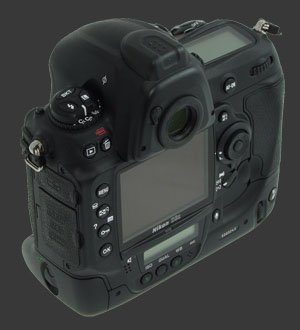
Nikon D3X Capability - What can it do?
As the top-of-the line professional full-frame DSLR from Nikon, the D3X unsurprisingly is suitable for all types of photography and has a rich feature set with plenty of customization options. Actually, it is easier to say what the D3X does not do rather than what it does:
- There is no built-in flash. Instead, it supports external lighting via a standard Hot-Shoe and Sync-Port.
- It does not have a dust-reduction mechanism. There is probably a technical reason for this but someone has to clean the sensor even for small dust particles.
- At 1.2kg (2.5 lbs), over 15cm (6") tall and wide, the D3X certainly does not afford discretion.
As one expects for this level of DSLR, the Nikon D3X has full manual-controls including program-shift and bulb mode, numerous white-balance settings including custom and Kelvin temperature, white-balance fine-tuning along 2 axis, sophisticated focus control including manual focusing, choice of metering patters, bracketing, a 100% coverage viewfinder, dual-controls dials and a huge number of external controls in a weather-sealed body.
 A 24 megapixels CMOS sensor lets the D3X capture images which can be printed at 18" x 24" with utmost quality. The high-resolution sensor has a standard ISO range for 100 to 1600 and can shoot continuously at 5 FPS for up to 70 JPEG images or 34 RAW files. The ISO range can be expanded to 50-6400. The downside of such high pixel-density is reduced sensitivity and frame-rate compared to cameras like the 12 megapixels Nikon D3S
A 24 megapixels CMOS sensor lets the D3X capture images which can be printed at 18" x 24" with utmost quality. The high-resolution sensor has a standard ISO range for 100 to 1600 and can shoot continuously at 5 FPS for up to 70 JPEG images or 34 RAW files. The ISO range can be expanded to 50-6400. The downside of such high pixel-density is reduced sensitivity and frame-rate compared to cameras like the 12 megapixels Nikon D3S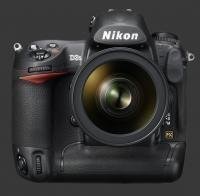
Nikon D3S which reaches a whopping ISO 102400 and 9 FPS.
The Nikon D3X includes a number of high-end features not found in all professional DSLRs:
- Auto Exposure Bracketing up to 9 frames with 1/3, 1/2, 2/3 or 1 EV increments.
- Multiple-Exposure: Up to 10 frames with optional auto-gain.
- Interval-Timer: Up to 9 shots at up to 999 intervals of between 1s and 24 hours, starting up to 23:59 minutes later.
- Built-in Viewfinder Shutter to prevent stray light from entering the camera during long exposures.
- Built-in Microphone for voice-annotation of images.
- Dual Compact-Flash slots with overflow, backup and format separation modes.
- Image Authentication signing. Adds a signature to images so that they can be verified as authentic later.
- Autofocus Fine-Tuning. Allows individual lenses to be adjusted for front or back focus in ±20 steps.
- Digital-Level, single axis, called Virtual Horizon. Displayable on rear color LCD or in the viewfinder.
Nikon D3X Usability - How easy is it to use?
This full-frame DSLR is designed for the professional photographer who is not afraid to carry something heavy and bulky for all the convenience that comes along. This is a plus-size DSLR that includes a vertical grip that accounts for its unusual height.
The second grip allows for more comfortable portrait-orientation shooting. It obviously adds a second shutter-release which is easy to accidentally trigger while shooting in landscape orientation due to its very soft halfway point, just like the other one. Thankfully, Nikon make the vertical release lockable. The vertical grip includes dual control-dials and a customizable AF-On button. It can be set to AE-L, AF-L or both instead of triggering AF. There is no EC button on that grip, which is something we wish the AF-On button could be programmed for.
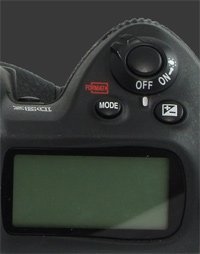 The Nikon D3X can be held firmly thanks to a comfortably sculpted main grip. The shutter, dual control-dials, Mode and EC buttons are all within easy reach while holding the camera in landscape orientation. The vertical grip does not afford the same level of ease since its control-dials are placed further from the release. Still, it is less tiresome than holding such a heavy camera vertically using the main grip.
The Nikon D3X can be held firmly thanks to a comfortably sculpted main grip. The shutter, dual control-dials, Mode and EC buttons are all within easy reach while holding the camera in landscape orientation. The vertical grip does not afford the same level of ease since its control-dials are placed further from the release. Still, it is less tiresome than holding such a heavy camera vertically using the main grip.
As mentioned, the D3X uses a Mode button rather than dial. To change modes, the button is held down while rotating the rear control-dial. This cycles through Program, Shutter-Priority (S), Aperture-Priority and Manual exposure modes. Manual is also used to access Bulb (B) and Flash-Sync (X) modes by selecting a special shutter-speed value.
Behind the the grip controls is a large status LCD. A flick of the power-switch illuminates it and the small status LCD at the back of the camera as well. Conveniently, the top status display shows the number of shots remaining and loaded memory card even when the camera is off.
 There are direct controls for every commonly used setting distributed all around the camera body. The rear status LCD, located below the 3" color display, is used to change ISO, Image Quality and WB. On either side of it are the microphone and voice-annotation button. Image Quality can select between RAW, TIFF, JPG or RAW+JPEG formats with JPEG available in 3 different sizes independently.
There are direct controls for every commonly used setting distributed all around the camera body. The rear status LCD, located below the 3" color display, is used to change ISO, Image Quality and WB. On either side of it are the microphone and voice-annotation button. Image Quality can select between RAW, TIFF, JPG or RAW+JPEG formats with JPEG available in 3 different sizes independently.
A 3" LCD with 920K pixels is found on the rear of camera. It has reasonable visibility, an excellent viewing angle and appears very sharp. The anti-reflective coating is only mildly effective though, so it can wash out under bright light. Reviewing images is a breeze except that the Pan & Zoom function works in an unusual way. Instead of zooming first and panning at that zoom level, these actions are done by moving and sizing a viewing rectangle. The 8-way controller moves it around and the rear control-dial adjusts its size. When the zoom button is released, the area is zoomed to fit the LCD display. This only takes a little time to get accustomed to but is quite efficient.
 To the left of the main display, a number of buttons, including the Zoom button, are found. Most of them serve a single function and are intuitively labeled. One oddity to see there is an OK button which is separate from the directional controller as it is on almost every other digital camera.
To the left of the main display, a number of buttons, including the Zoom button, are found. Most of them serve a single function and are intuitively labeled. One oddity to see there is an OK button which is separate from the directional controller as it is on almost every other digital camera.
Speaking of all theses buttons, they are all well-sized, easy to press and quite responsive. The button labeled with a key is Protect which prevents an image from being deleted unless the memory card is formatter. Play works just as expected and the camera is Shooting-Priority, meaning that a half-press of any shutter brings it instantly back to shooting mode.
The other side of the main display is busy too but leaves plenty of room to hold the camera well. Part of the rear plate is occupied by the memory card compartment door. Opening it is fiddly. A hard plastic flap must first be lifted and then a round button behind it most be pressed. Care must be taken not to block the door while doing so which is all too easy. Needless to say, this memory compartment is not about to open accidentally.
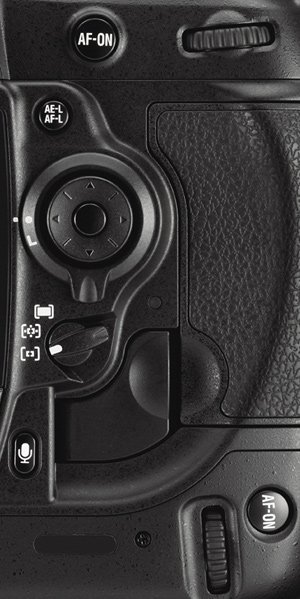 Both rear control-dials and both AF-On button are located close to the camera edges. The dials have click points to prevent accidental changes and good ridges move them without slipping. The lower one is slightly recessed with makes it a little more difficult to use with gloves on.
Both rear control-dials and both AF-On button are located close to the camera edges. The dials have click points to prevent accidental changes and good ridges move them without slipping. The lower one is slightly recessed with makes it a little more difficult to use with gloves on.
Close to the main display is the 8-way controller which moves around the focus in shooting mode. Due to the number of focus-points in the D3X, the active one can be moved individually or as a group representing an area. Since the 8-way controller is relatively soft, there is a lock around it which is used to lock focus in place. Just below is a 3-way rotating switch to select the AF Point-Selection mode between Center, Manual and Automatic.
Above the directional controller is the customizable AE-L/AF-L button. By itself, it can be assigned one of 16 functions:
- Depth-Of-Field Preview
- Flash Value Lock
- AE/AF Lock
- AE Lock Only
- AE Lock with Reset On Release
- AE Lock Hold
- AF Lock Only
- AF-On
- Flash Off
- Bracketing Burst
- Matrix Metering
- Center-Weighed Metering
- Spot Metering
- Virtual Horizon
- Playback
- Top My Menu item
These same functions can be assigned to the DOF Preview and Function buttons. AF-On can be assigned functions one from functions 3 to 8. Additionally a separate function can be assigned when the button is used in conjunction with a control-dial. Note that to access the Virtual Horizon (Digital Level) one of these buttons much be assigned to it. When the button assigned to Digital Level is pressed, the viewfinder shows a tilt indicator in place of the exposure meter. This is somewhat awkward since the button must be held while adjusting camera tilt.
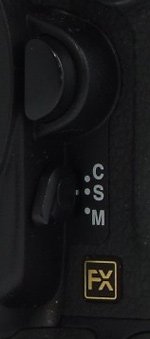
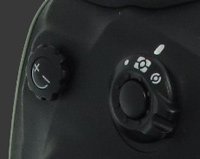 The focus mode is controlled by a 3-way switch next to the mount. Three options are available: Single-Shot (AF-S), Continuous (AF-C) and Manual (MF). There is another 3-way switch on the side of the viewfinder prism that selects a metering mode. The three options are Matrix, Center-Weighed and Spot. Center-Weighed is configurable with different sizes of centers or as average metering, meaning equal weight is given to the center and surrounding area.
The focus mode is controlled by a 3-way switch next to the mount. Three options are available: Single-Shot (AF-S), Continuous (AF-C) and Manual (MF). There is another 3-way switch on the side of the viewfinder prism that selects a metering mode. The three options are Matrix, Center-Weighed and Spot. Center-Weighed is configurable with different sizes of centers or as average metering, meaning equal weight is given to the center and surrounding area.
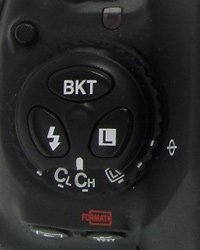 The final controls of the Nikon D3X are on top of the camera to the left of the prism .A locked rotating dial controls the drive mode, offering a choice of single-shot, high-speed and low-speed continuous, live-view, self-timer and mirror up. Above the drive-mode dial are three buttons to use with control-dials: Bracketing, Flash and Lock.
The final controls of the Nikon D3X are on top of the camera to the left of the prism .A locked rotating dial controls the drive mode, offering a choice of single-shot, high-speed and low-speed continuous, live-view, self-timer and mirror up. Above the drive-mode dial are three buttons to use with control-dials: Bracketing, Flash and Lock.
To set bracketing the front control-dial selects the increment size while the rear control-dial selects the number of shots. Both Flash and Lock use the rear control dial to cycle between options. Lock is used to lock exposure parameters from changes.
Overall, ergonomics of the Nikon D3X are great once you get past the size and weight of this DSLR. The main grip is perfectly ergonomic and most buttons are easy to reach and perform their function with surprises. There are plenty of buttons - many of them customizable - to provide access to all important photographic controls. There are so many buttons that accessing the menu system is rarely required. Assuming the Virtual Horizon function was assigned to a button, the only function from the menu that may be accessed more than rarely is the self-timer duration.
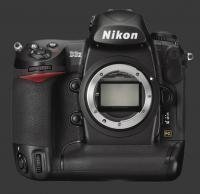 |
Please Support Neocamera
All information on Neocamera is provided free of charge yet running this website is a huge endeavor. Purchases made via affiliate links found throughout the site help keep it running and up-to-date. There is no additional cost to you, so please consider buying via these links to our affilates:
If you found any information on this site valuable and did not purchase via our affiliate links, please considering donating via PayPal:
Any amount will be greatly appreaciated. Thank you for your support!
Nikon D3X Highlights

Sensor-Size: 36 x 24mm

Actual size when viewed at 100 DPI
| 25 Megapixels DSLR | ISO 50-6400 |
| Nikon F Mount 1X FLM | Shutter 1/8000-30s |
| 100% Coverage Extra Large Viewfinder | Full manual controls, including Manual Focus |
| 1 Axis Digital Level | Custom white-balance with 2 axis fine-tuning |
| Weatherproof | Spot-Metering |
| 5 FPS Drive, 70 Images | Hot-Shoe & Sync-Port |
| 3" LCD 920K Pixels | Lithium-Ion Battery |
| Compact Flash x 2 |
Updates
2024.11.18

Best 2024 Photography Gifts for Every Budget
Great gifts for photographers and photo enthusiasts selected for every budget among the best products of 2024.
2024.08.07

Eye Protection Tips for Professional Photographers
The four main considerations for professional photographers regarding eyewear.
2024.07.14

Fujifilm X100VI Review
Flagship fixed-lens compact digital camera with a 40 MP sensor and Image-Stabilization, a first for the series. Retro design featuring dual control-dials, plus direct ISO, Shutter-Speed and EC dials. Its hybrid viewfinder can switch between EVF and OVF mode.
2024.05.09

Fujifilm GFX100 II Review
Flagship 102 Megapixels Medium-Format Mirrorless Digital Camera with 8-Stop 5-Axis IBIS, 8 FPS Drive, 8K Video and 400 MP Super-Resolution capture in a weatherproof and freezeproof body with dual control-dials and dual memory-card slots.
2024.04.03

Fujifilm X-T5 Review
Newest Fujifilm flagship boasting a 40 MP APS-C sensor, 5-axis IBIS with 7-stop efficiency, 15 FPS continuous drive, 6.2K Video capture, dual control-dials and dual SDXC UHS-II slots in a sturdy weatherproof and freezeproof body.
2023.11.20

Best Digital Cameras of 2023
Find out which are the Best Digital Cameras of 2023. All the new Mirrorless Digital Cameras from entry-level to high-end professional.
2023.07.10

Fujifilm X-H2 Review
40 Megapixels APS-C Hybrid Mirrorless Digital Camera with 7-stop IBIS. Fastest shutter ever and 8K video capture. Large builtin EVF with 0.8X magnification and 5.8 MP, plus an Eye-Start Sensor. Packed with features and large number of controls in a weatherproof and freezeproof body.
2023.05.07

Sony FE 20-70mm F/4G Review
Review of the unique Sony FE 20-70mm F/4G lens. The optical zoom of this lens spans ultra-wide-angle and medium focal-length coverage, making it one of the most versatile Full-Frame lenses on the market.
2023.01.15

Huion Inspiroy Dial 2 Review
Review of the Huion Inspiroy Dial 2 tablet, a medium sized drawing surface with dual dials and customizable buttons. Connects via USB-C or Bluetooth 5.0 with Windows, Linux and Android support.
2022.12.08

How to Pack for a Photo Trip
Find out how to pack for a travel photography trip, carry your gear safely while meeting airline regulations.
2022.11.13

Best Digital Cameras of 2022
The best digital cameras of 2022. A short list of the most outstanding models in their respective categories. Choose one for yourself or as a gift.
2022.09.21

Pentax DA* 60-250mm F/4 SDM Review
Review of the Pentax DA* 60-250mm F/4 SDM, the constant-aperture telephoto zoom with the highest zoom-ratio on the market.













